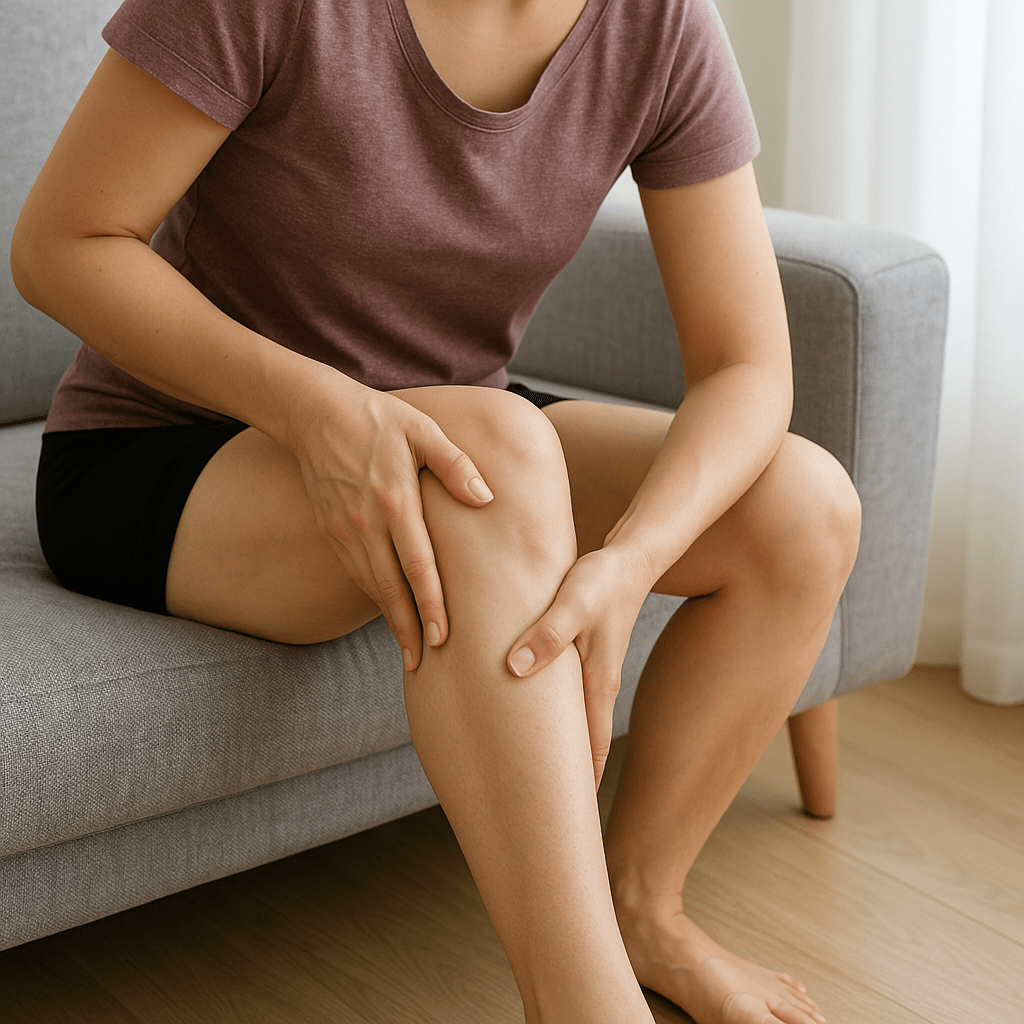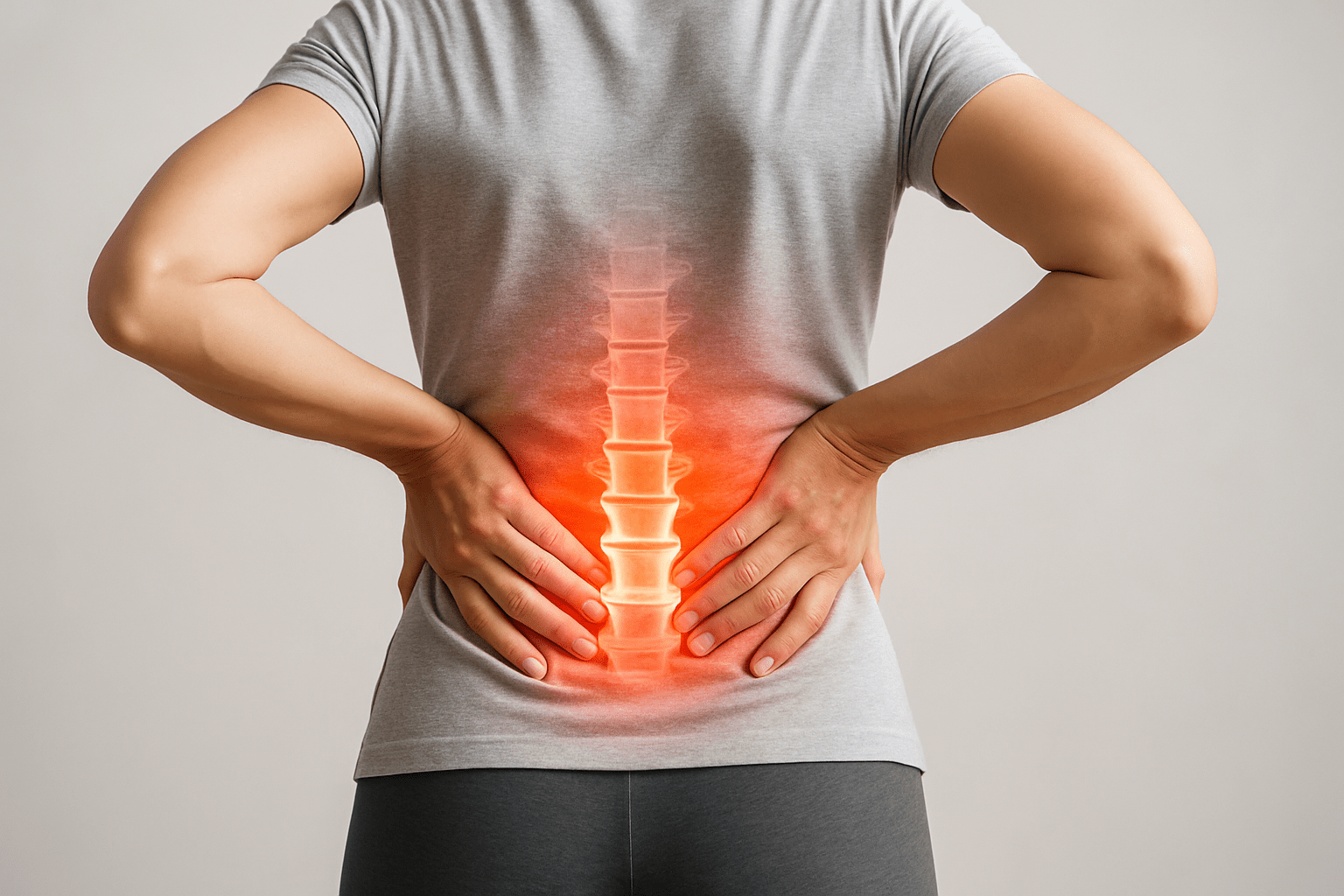Arm pain and tennis elbow: what's behind it and what helps?
The human arm has over 30 muscles and more than a dozen joints - and yet a single wrong movement is often enough to cause pain. Our arms are masterpieces of mobility: we write, grip, lift, type, screw and often do this for hours on end without a break. So it's no wonder that overloading often occurs in the elbow area in particular. A well-known example is tennis elbow. But it doesn't just affect athletes. In this article, you will find out what is behind the symptoms, who is particularly at risk and what you can do yourself to prevent or alleviate arm pain. Reading tip right up front: From head to...


The human arm has over 30 muscles and more than a dozen joints - and yet a single wrong movement is often enough to cause pain.
Our arms are masterpieces of mobility: we write, grip, lift, type, screw and often do this for hours on end without a break. So it's no wonder that overloading often occurs in the elbow area in particular. A well-known example: the so-called tennis elbow. But it doesn't just affect athletes.
In this article, you will find out what is behind the symptoms, who is particularly at risk and what you can do yourself to prevent or relieve arm pain.
Reading tip right up front: From head to toe - How massages have a holistic effect on your body
But first the basics:
What is tennis elbow (lateral epicondylitis)?
Precisely because our arms are so versatile and resilient, they often only become noticeable when certain movements suddenly hurt or are no longer possible. The pain is particularly common on the outside of the elbow. Many sufferers report a sharp pulling sensation when gripping, lifting or turning. Even everyday movements such as carrying a shopping bag or opening a screw cap can become painful.
In many cases, these symptoms are caused by the so-called tennis elbowmedically known as lateral epicondylitis humeri in medical terms. This is a painful overuse reaction in the area of the outer elbow. The tendon insertion of the forearm extensor muscles is primarily affected, usually the extensor carpi radialis brevis muscle.
The complaints are caused by repeated micro-injuries at this tendon insertion site - a so-called insertional tendopathy. This microdamage leads to inflammatory irritation, which can be felt during exertion or at rest.
Contrary to the name, however, the disease has little to do with tennis: Most patients have never held a racket in their hands. Instead, it is everyday, monotonous movementsat the computer keyboard, doing manual work or in the household, for example, that have made tennis elbow a widespread modern disease.
Common causes of arm pain - beyond tennis elbow
Of course, tennis elbow is a common cause of discomfort in the elbow area, but arm pain is a very complex symptom and can come from very different sources. Depending on where the pain occurs (shoulder, upper arm, elbow, forearm or hand), when it occurs (during movement, at rest, at night) and how it feels (stabbing, dull, pulling, burning), there are many different possible causes.
To give you a better feel for what can be behind arm pain, here are the most common triggers, explained and categorized:
Muscle tension or muscle injuries
It is often not the joints or nerves that cause pain, but simply tense or overloaded muscles. Sitting for too long, incorrect posture or intensive strain during sport can lead to persistent tension, particularly in the shoulder and neck area, which then radiates into the arm.
Even minor muscle injuries (e.g. due to overstretching or microtrauma during training) cause pain. Typical: pulling pain, tenderness and sometimes a feeling of muscle soreness.
Tendon or tendon sheath inflammation
If a tendon is overstretched, this can lead to painful tendinitis (tendon inflammation) or tendovaginitis (tendon sheath inflammation) - often in the wrist, elbow or shoulder.
These complaints occur particularly during monotonous activities such as typing, screwing, writing or manual work. The tendon becomes hot, thick and extremely sensitive to pressure and movement. In severe cases, movement is almost impossible.
Joint wear and tear (arthrosis), arthritis
Degenerative changes, such as those that occur with osteoarthritis, often affect the shoulder, elbow or wrist. The joint cartilage increasingly wears away, leading to pain, stiffness and restricted movement. Inflammatory diseases such as arthritis (e.g. rheumatoid arthritis) are also accompanied by swelling, redness and a general feeling of illness. A so-called "start-up pain" is also typical - i.e. pain after periods of rest.
Herniated disc in the cervical spine (cervical spine)
Even if the pain is in the arm - the cause may lie in the neck. A slipped disc in the cervical spine can press on nerve roots that are responsible for supplying the shoulder, arm and hand.
The result: radiating pain, tingling, numbness or even loss of strength in the arm. The symptoms often increase with certain head postures or strain.
Carpal tunnel syndrome and other nerve impingement syndromes
In carpal tunnel syndrome, the median nerve in the wrist is constricted, usually due to repetitive strain or anatomical constriction. Those affected experience tingling, numbness or pain in the hand (especially the thumb, index and middle fingers), often at night. Other nerve compressions - for example at the elbow (ulnar sulcus syndrome) - can also cause pain or discomfort in the arm.
Circulatory disorders or thromboses
If the arm suddenly swells, feels cold, discolored or dully painful, this may be due to a circulatory disorder or even thrombosis - a dangerous vascular disease in which a blood clot blocks the blood circulation. This cause should be urgently clarified by a doctor, as in extreme cases it can lead to a pulmonary embolism or tissue damage.
Overload due to monotonous movements ("mouse arm")
People who work a lot on computers in particular often experience irritation of the muscles and tendons due to constant, small movements, such as clicking and scrolling.
The so-called "mouse arm" or RSI syndrome (repetitive strain injury) is a typical example of modern stress complaints. It manifests itself through pain, stiffness or tingling. It often starts in the hand and radiates to the elbow or shoulder.
Accidental injuries or broken bones
Last but not least, acute events such as falls, blows or accidents can also lead to bruises, strains, dislocations or even fractures. A broken bone is not always immediately visible, sometimes there is only swelling, bruising and immobility. If the pain is very severe or occurs after a fall: always seek medical advice.
Beware of sudden pain in the left arm!
A special case, but extremely important, especially in men, is sudden pain in the left arm, particularly if it is accompanied by tightness in the chest, shortness of breath, nausea or cold sweat. This may indicate a heart attack - an absolute medical emergency. In this case, call the emergency number (112) immediately and provide first aid.
Who is particularly at risk?
Arm pain, especially that caused by overuse, does not only affect top athletes or people with physically demanding jobs. In fact, many sufferers belong to professional or everyday groups who put seemingly "harmless" but permanent one-sided strain on their arms.
Professionals in the office or working from home
Anyone who works at a computer for hours every day, typing, clicking, scrolling or talking on the phone, often puts one-sided and repeated strain on their arm and hand muscles. Poor ergonomics, cramped postures and a lack of breaks increase the risk of muscle tension, tendon irritation and ultimately tennis elbow or RSI syndrome ("mouse arm").
Tradespeople, fitters and physical laborers
Professions with high mechanical stress, such as tilers, mechanics or carpenters, often work with vibrating tools or in forced postures. Particularly problematic: activities that require a lot of strength in the forearm and wrist. Working constantly overhead or with heavy equipment can lead to irritation of the tendon insertions, mainly around the elbow.
Musicians:inside
Violin, guitar, drums or piano - many instruments require precise, repetitive movements. This puts disproportionate strain on certain muscle groups in the arm. In addition, both professional and amateur musicians often practice a lot without sufficient recovery time. The risk of chronic overuse is high.
Athletes - not only with rackets
Tennis, squash or badminton are considered classic triggers for tennis elbow, hence the name. However, sports such as climbing, rowing, weightlifting and swimming also put a lot of strain on the forearm muscles. If you start without a targeted warm-up or correct technique training, you increase the risk of micro-injuries and tendon irritation.
Household activists, gardeners and DIY enthusiasts
Chronic overload can also occur outside of work, for example when painting, cleaning windows, weeding or carrying shopping bags for hours on end. Repetitive strain in everyday life is often underestimated, especially if it is unergonomic or one-sided.
Between 35 and 55 - the typical age
Statistics show: Tennis elbow-type complaints occur most frequently in people between the ages of 35 and 55. At this age, the muscles are fundamentally efficient, but at the same time the elasticity of tendons and connective tissue slowly decreases, which increases the susceptibility to injury during prolonged strain.
Symptoms: How to recognize tennis elbow
Not every pain in the elbow means tennis elbow, but there are some typical warning signs that you should take seriously. Tennis elbow usually develops gradually: initially, you may only feel a slight pulling sensation or discomfort when making certain movements. However, without targeted countermeasures, the discomfort can quickly increase and ultimately significantly restrict your everyday life.
Pain on the outside of the elbow
The main symptom is a dull to stabbing pain on the outer side of the elbow, directly above the bony prominence, the so-called lateral epicondyle. Initially, the pain usually only occurs under stress, for example when carrying, lifting or gripping. Later, it can also be felt at rest or at night.
Amplification for certain movements
Typically, the pain intensifies when you work against resistance, for example when lifting an object, opening a glass or shaking hands. Typing or working with the mouse can also provoke the pain.
Radiation into the forearm or wrist
In many cases, the pain radiates into the forearm or wrist. This is because the affected muscles are responsible for the extension movement of the wrist and fingers. A pulling sensation along the outside of the arm may indicate that the irritation has already spread beyond the elbow joint.
Loss of strength and insecurity when gripping
Another indication: gripping movements become more difficult or feel unsteady, even simple everyday tasks such as holding a cup or carrying a basket become uncomfortable. Advanced irritation can lead to a noticeable loss of strength.
Restriction of movement and relieving posture
Many sufferers unconsciously try to avoid the painful movements, which leads to a relaxed posture. This in turn can trigger tension in the shoulder/neck area and cause new problems. In some cases, there is also a real restriction of movement in the elbow.
Swelling or tenderness
Occasionally, the affected area also becomes slightly swollen or reddened, especially in the case of acute inflammation. Even light pressure with the finger on the tendon insertions can cause pain.
What helps? Conservative treatments that work
The good news first: in the vast majority of cases, tennis elbow can be treated without surgery successfully without surgery. The decisive factor is that you take countermeasures at an early stage and rely on a combination of of rest, targeted exercises, heat, massage and ergonomics and ergonomics.
Here you can find out what really helps - scientifically sound and explained in a way that is suitable for everyday use:
a) Self-help exercises: active instead of passive
Complete immobilization is generally not advisable. Instead, experts recommend targeted, active exercises that strengthen the muscles, promote blood circulation and reduce irritation. The following exercises have proven to be effective:
-
Eccentric exercisese.g. slowly lowering a small weight with the wrist extended
-
Stretching exercises for the forearm muscles (e.g. pull the fingers down with the other hand)
-
The classic "towel wringing" - a movement that improves grip strength and mobility
-
Exercises with the Therabandto specifically strengthen the muscles
Tip: Do the exercises regularly, but pay attention to your body's signals. It should pull, but not hurt too much. If you are unsure, it makes sense to visit a physiotherapist.
You can also find inspiration here: What helps against back pain?
b) Massage treatments: Relaxation with a deep effect
Massages are one of the most popular treatments for muscle and tendon complaints, and rightly so: they relieve tension, stimulate lymph flow and increase blood circulation. They are helpful in connection with tennis elbow:
-
Classic massages in the area of the forearm and shoulder muscles
-
Trigger point massages for the targeted release of hardening
-
Shiatsu and deep tissue techniqueswhich are also used in high-quality massage chairs
Important: Never massage directly on the inflamed tendon insertionsbut around the affected muscles. A good addition to active exercises.
Reading tips:
c) Heat, stretching and ergonomic measures
Heat can work wonders, especially for chronic tension: Heat pads, mud packs or an infrared cabin promote blood circulation, relax the muscles and relieve pain. On the other hand, cooling is better for acute bouts of inflammation, for example with a cooling pad for a few minutes several times a day.
In addition:
-
Stretch the forearm muscles regularly, especially after exercise.
-
Design your workplace ergonomically: Make sure your desk, chair and armrests are at the right height and position your mouse and keyboard so that your arms remain relaxed.
-
Avoid forced postures and take exercise breaks at least every 45-60 minutes.
Tip for your relaxation oasis at home: Discover the MSW 300 massage chair
Can massage chairs help with arm pain?
The short answer: Yes - in many cases, massage chairs can be a useful aid in the treatment of arm pain, especially if muscular tension is the cause or an accompanying factor.
Of course, a massage chair cannot replace a physiotherapist, but it does offer a practical, effective and comfortable way to regularly treat tension and take preventative action. High-quality massage chairs can make a real difference, especially for complaints caused by one-sided strain or incorrect posture.
This is how massage chairs work for arm and shoulder pain:
-
Targeted relaxation of tense muscle groups: A lot of pain in the arm does not arise directly in the elbow, but in the shoulder and neck area, where important nerves and muscles originate. Massage chairs with Shiatsu or tapping techniques effectively release tension and relieve the structures involved.
-
Promotes blood circulation: The mechanical movements and the optional integrated heat function stimulate blood circulation and thus the regeneration of tissue and muscles.
-
Stress reduction: Chronic stress can increase muscular tension. Regular relaxation phases in the massage chair help to calm the autonomic nervous system, which often also has a positive effect on physical complaints.
-
Long-term use, without additional costs: Having your own massage chair at home offers the great advantage that you can treat regularly, individually and without the stress of appointments. This is a big plus point, especially for chronic complaints.
Which armchair is particularly suitable?
A good example is the MSW 300 massage chair. It combines:
-
Shiatsu technique with pressure point massage
-
Air pressure massage for shoulders and arms
-
Heat function
-
Automatic programs for daily use
Such a chair cannot replace medical therapy - but it complements it ideally, especially in the context of prevention, regeneration and self-care.
More inspiration: Discover our health collection
When should you see a doctor?
As helpful as self-help, exercises and massage can be - not every type of arm pain belongs in self-treatment. There are clear warning signs where you should not hesitate to seek medical help. After all, seemingly harmless complaints can conceal serious illnesses that require targeted medical diagnosis and treatment.
Here are the most important situations in which you should definitely seek medical advice:
Sudden severe pain - especially in the left arm
If the pain is sudden, severe and unusual, mainly in the left arm, and possibly accompanied by chest tightness, shortness of breath, nausea or sweating, a heart attack is suspected. In this case, call the emergency services immediately (112) - every minute counts.
Sensory disturbances, numbness or paralysis
Tingling, numbness or even loss of strength in the arm or fingers can be signs of nerve compression or damage, for example due to a herniated disc in the cervical spine or a bottleneck syndrome. The earlier you are diagnosed, the better the prognosis.
Severe restriction of movement or swelling
If your arm is swollen, overheated or reddened and you can hardly move it, there may be inflammation, bursitis or even joint effusion. A medical examination and, if necessary, imaging (e.g. ultrasound or MRI) will clarify the situation.
No improvement despite self-treatment
If you are already doing exercises, using massages or have made ergonomic changes to your workstation and the symptoms still do not improve or even worsen after two to three weeks, it is time for a medical check-up. Chronic overload can otherwise become entrenched and lead to permanent problems.
Accident, fall or external injury
If you experience pain after a fall or external force, you should always seek medical advice to rule out broken bones, torn ligaments or joint injuries. Even if you can still move your arm, this does not automatically mean that nothing has been injured.
That's why it's better to see a doctor once too often than too little. If detected early, many causes of arm pain can be treated effectively and sustainably and you can get moving again more quickly.
Prevention: how to stay pain-free

Good prevention is even better than any treatment. Many causes of arm pain - especially overuse injuries such as tennis elbow - can be avoided with simple but consistent measures in everyday life. If you know your movements, set the right stimuli and listen to your body signals, you can often completely prevent or at least greatly reduce discomfort.
Here is your personal anti-pain strategy:
Stretch and strengthen regularly
Stretching exercises keep your muscles supple, prevent shortening and improve mobility. Make sure you also do strengthening exercises to distribute the load better, especially for the forearm, shoulder and back. Just 5-10 minutes a day can make a difference.
Set up an ergonomic workstation
Much of the discomfort in the arm is caused by poor posture while sitting. Look out for:
-
Correct table and seat height
-
Wrist in neutral position (not bent!)
-
Ergonomic mouse and keyboard
-
Upholstered armrests
-
Regular breaks (e.g. Pomodoro technique: work for 25 minutes, move for 5 minutes)
Incorporate posture changes and breaks
Always in the same position? Poison for your muscles. Change your posture regularly, stretch in between, stand up briefly or shake your arms out. Your muscles need this micro-relief, not just when it hurts.
Grip, lift and move correctly
Whether you're doing sport or carrying shopping bags: Learn the correct movement patterns to avoid incorrect strain. If possible, lift from your legs, not from your back or purely with your arms. Avoid hyperextending your wrists and avoid gripping too tightly when doing fine work.
Warm-up before exercise - even in everyday life
You should not only warm up in the gym: Housework, gardening or manual activities also put strain on your muscles. A short warm-up (e.g. circular movements of the arms, stretching) protects against irritation and muscle tension.
Listen to your body - act early
When you feel the first symptoms: react early! Small changes, deliberate breaks and targeted relief will help you to prevent symptoms from becoming chronic in the first place.
In conclusion: Thirty muscles, zero discomfort - that's it!
Over 30 muscles work together in your arm every day, a true masterpiece of nature. Unfortunately, they are not infinitely resilient. But the good news is: with a little attention, the right exercises and small changes to your daily routine, you can give your arms exactly the support they deserve.
So, don't wait until your elbow feels like it's been through a Grand Slam final, but take action early on. Whether with targeted stretching exercises, improved posture in the office or a relaxing massage chair in the evening: your arm team will be happy about any relief.
Stay loose, but not sloppy. And remember: you don't need a tennis racket to get tennis elbow. But you don't need a prescription to prevent it either. Just a little exercise, mindfulness and maybe a massage in between.
Discover supportive products and solutions in our health collection
Or treat yourself to daily deep relaxation with the MSW 300 massage chair
Further contributions
Note: This article does not replace medical advice. In case of chronic complaints, acute pain or diagnosed illnesses, you should consult your doctor or therapist before use if in doubt.

Co-founder and Managing Director of Massage Chair World. With his expert knowledge and industry expertise, he helps private individuals and companies to find the right massage chairs for relaxation, health and vitality. The individual expert advice is provided both by telephone or video chat, as well as in the exhibition outside Stuttgart.




